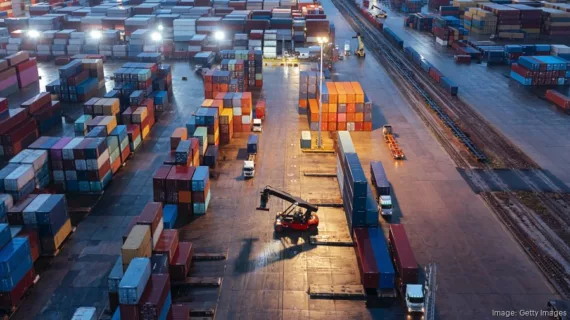MEDIA CONTACT:
Justin Scott
816.809.3116
justin@scott-comms.com
Market update: Navigating volatility in the transportation market
Many businesses rely on freight and logistics services to deliver their products, and with increasing volatility, companies and consumers alike are facing a potentially unsettling situation
This story originally appeared in the Kansas City Business Journal.
Read any headline on your phone or tune into the nightly news on any channel and you can’t avoid it: recession looming. Five signs we’re headed for a recession. UN warns of a global recession. And with record gas prices, a hot housing market and inflation concerns – it’s hard not to think back to what it looked like in late 2007 just before the Great Recession in 2008.
I’m not an expert in economic predictions or what it takes to decrease inflation; there are analysts and economists who are paid handsomely to address those issues. But when it comes to the freight industry and how the end consumer (business) is impacted, that’s something I’m invested in — taking a macroeconomic issue and pairing it down to a micro level, specifically focusing on:
- Contributors to a volatile freight market.
- How the mid-market is affected.
- What resources are available to combat negative impacts.
Many businesses rely on freight and logistics services to deliver their products, and with increasing volatility, companies and consumers alike are facing a potentially unsettling situation.
Contributors to a volatile freight market
Rising fuel costs: As the world’s economies grow, countries need more and more goods to keep pace. This has led to a sharp increase in freight demands. Unfortunately, this increase is being driven by several factors that are difficult to control, namely rising fuel costs. Russia, one of the world’s largest producers of oil, is currently facing sanctions from Western nations in response to the invasion of Ukraine. This means that the world’s oil supply has dramatically decreased and is the main reason for rising energy costs around the world.
The transportation industry uses a great deal of fuel, and as a result, fuel costs have risen tremendously driving an increase in shipping rates and impacting ground freight, rail freight, air freight and ocean cargo. In fact, U.S. shippers are seeing a 20% drop in ocean-freight orders, and freight prices on one key route from Asia to the West Coast are down more than 80% from last year, according to a CNBC report.
Driver and equipment shortages: Recently, we discussed the labor shortages that are negatively impacting the supply chain as well as facing the driver shortage battle due to poor pay, working conditions and a lack of dignity within the profession. According to American Trucking Associations (ATA), the driver shortage is at a historic high with no end in sight. Over the next decade, more than 1 million new drivers will be needed to replace those leaving the market and enable growth, the ATA reports.
On top of the driver shortage, the equipment shortage is also contributing to the volatile market.
Industry experts reveal that some truck makers are currently not accepting new orders. Most of them have large backlogs and are afraid of adding any more. Due to these shortages, older trucks are now going at the same prices as the new ones, leaving fleets with aging equipment and rising maintenance costs.
Since last year, the U.S. trailer industry has been dealing with a major backlog. According to one estimate, the industry is short 100,000 units, and The Wall Street Journal reports that Lafayette, Indiana-based equipment maker Wabash National Corp. expects to produce about 25% fewer trailers this year than it did before the pandemic because of shortages of everything from foam insulation to suspension components and taillight wiring. The Washington Post reported that automakers, including semi-truck makers, which rely on dozens of chips to build a single vehicle, have been particularly hard hit, forced to halt production lines globally as they await chip supplies. The debacle is likely to cost the auto industry $450 billion in global sales from the start of the crisis through the end of 2022, according to Seraph Consulting.
Soaring insurance premiums: Insurance premiums have risen by 47% over the past 10 years from $0.059 to $0.087, according to a February report by the American Transportation Research Institute. Accidents are not the only factor in rising insurance premiums; there are also rising medical and litigation costs, which is one of the more substantial factors. Small verdicts and settlements result in payments of anywhere between $406,386 and $449,792, according to the same report. Settlements like that are enough to strain the insurance companies who then pass the pressure on to the motor carriers they insure, and small fleets are feeling the brunt of the hit, negatively impacting available carrier capacity.
How are mid-market businesses impacted?
As the conflict in Ukraine escalates, small and mid-size business (SMB) supply chains are increasingly vulnerable to disruption from the conflict abroad.
Nine out of 10 small and mid-size enterprises believe that larger organizations have an advantage over them in acquiring merchandise, and 86% of SMB shops have already experienced or anticipate experiencing the effects of the international dispute.
Small to mid-sized businesses struggle with this new reality because they place orders on customer needs rather than in bulk. Large firms don’t have as much trouble keeping up with demand when there is a supply chain disruption since they frequently place larger purchases and pose less risk to suppliers than small enterprises.
Large corporations can also tolerate (and even absorb) rising prices better than small businesses. The pressure on the retail sector from rising expenses is great enough that they have little choice but to at least partially distribute increased shipping prices to their customers. The market fluctuation poses a great danger to small businesses, as they’re more likely to get caught in the crossfire of price wars.
Larger corporations have the resources and connections to ride out the waves of fluctuation in the market. They can take advantage of opportunities when they arise, and ensure they avoid getting caught in any dead-end deals or contracts that may prove detrimental. Their size allows them to weather these storms without going under.
Small to mid-market businesses don’t have that luxury. Many lack the resources or connections needed to ride out such turbulence, so when prices spike or dip unexpectedly, many small businesses are forced into bankruptcy and disappear from the scene entirely — leaving only mega-conglomerates and multi-billion-dollar corporations on top of an increasingly monopolized market.
One of the best methods to reduce the risks associated with an unstable supply chain is to diversify your supply network. Think about working with suppliers who provide a variety of goods and services so you have backup plans in case one of them fails or starts to overcharge, and in doing so, you can better defend against price increases and supply-chain hiccups.
Available resources to combat negative impacts
As the market continues to throw mixed signals, today is different from 2008’s Great Recession because there are still processes mid-market businesses can put in place to better manage the in-between.
One thing we know for sure is that increased interest rates are likely to be around for at least some time. “The good news, such as it is, is that higher rates, while unpleasant and potentially painful, are becoming less of an uncertainty and more of a sure thing,” contributing authors to a McKinsey.com article shared. “Companies need to draw on the proven playbook for success in a world of slower growth, higher inflation and more expensive capital.”
Companies can build resilience and extract savings from already-lean supply chains by carefully assessing supply chain vulnerabilities, revealing opportunities to lower spending with high-risk suppliers by 40% or more. Another option is to adjust transportation modes, routes and distribution footprints around tensions, tariffs and disruptions, potentially lowering transportation costs by 25%.
Finally, consolidating organizational responses is a must. Proactive responses include sharing data with suppliers and carriers to analyze the supply chain for weaknesses, disruptions and competition. Automation and artificial intelligence (AI) are useful technologies that may speed up your supply chain and keep you competitive in your niche in a world where speed and accuracy are essential for success. You can anticipate seeing a higher level of personalization in many supply chain segments as well as a bigger focus on data security.
Technology is a powerful force in supply chain management, but so are the people who use it. Every firm should prioritize maintaining positive working relationships; improve collaboration and cooperation at each stage; and concentrate on strengthening your connections with your team members, vendors and suppliers. It could be the difference between market sustainability and calamity.
About Dynamic Logistix
With more than $1 billion in managed freight under TMS management, Dynamic Logistix is always looking for reliable carriers to partner with. For more information, please visit our website.
Dynamic Logistix is a third-party provider of shipping and freight solutions that combines a world-class technology platform with stellar personal service. Our technology, our culture and our connections with shippers allows us to provide premium shipments to our carrier network.





